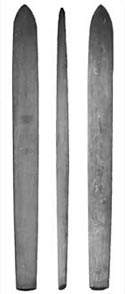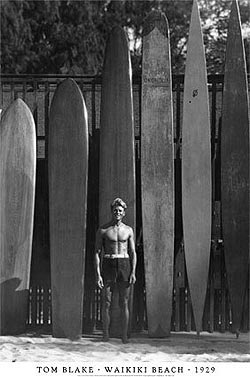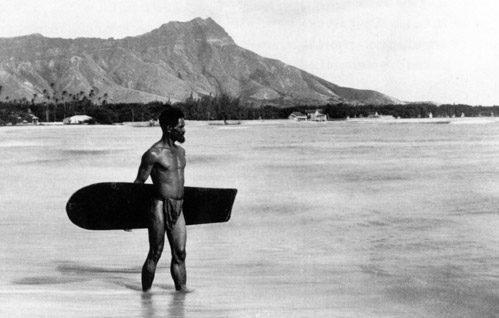We came a long way in the history of surfboards. Can you imagine riding a 35kg/77lb heavy wooden surfboard with no fins and no rocker? I can’t. This is exactly how the first solid surfboards looked like. So these days we can be grateful for new materials and light surfboards that fit under our arm as the fist surfers were (actually would be, if they knew what lays ahead) grateful for clean oceans and empty lineups. How surfboards evolved through history from unimaginably heavy wooden planks to light and maneuverable surfboards? Read on…
Table of Contents
Solid Surfboards

Wood used to make solid surfboards came from a variety of different trees depending upon what was available locally. For example in California – Redwood was commonly used. In ancient Hawaii, where surfing was a part of the culture, surfboards were more that just big pieces of wood. Special types of trees could only be used by Hawaiian Royalty to shape their own royal surfboards.
Needless to say, a solid wooden surfboard does not float as well as a modern surfboard made out of foam. To compensate for this, old boards were just a little bit longer and heavier than modern surfboards.
You had to be in good shape just to bring your surfboard to the beach!
Solid surfboards could be anywhere from 10 feet (3m) up to 20ft (6m) long and were extremely heavy (they started at around 35Kg/77lbs and went up to 68kg/150lbs or even 91kg/200lbs). Once you trucked your surfboard to the ocean you found another bug in these surfboards – old solid surfboards had no fin and no rocker, so they could only be surfed in a straight line. Good side of this was that one wave one surfer rule was none existent and everybody could ride the same wave. There were also no feather light groms in the water as they were unable to move the surfboard from daddy’s garage.
Solid surfboards were still in use up until the late 1930’s.
The worlds oldest surfboard?
The world’s oldest surfboard is displayed in the Bishop Museum in Honolulu, Hawaii. It celebrated more that 230 birthdays. The board was used on Hawaii and was ridden by Hawaiian royalty. It dates back to the time when Captain Cook first saw surfing in the Hawaiian Islands in 1778.
Hollow Surfboards

New materials and techniques brought the use of marine plywood and waterproof glues into surfboard construction and made it possible to build a hollow surfboard. They were constructed using a wooden framework which was covered with plywood and then varnished.
Who came up with the idea of a hollow surfboard?
Hollow surfboards were invented in 1926 by a surfer named Tom Blake (1902 – 1994). Besides being one of the most influential and important figures in the history of surfing Tom Blake was also a national swimming champion, inventor, author and actor. Hollow surfboards soon replaced the old solid surfboards. They were much lighter (around 20kg/44lbs) and easier to handle. Still the shapes of hollow surfboards were similar to solid boards which gave them the same “poor” performance. These hollow-core surfboards dominated the surfing world until the late 1940’s.
Lets Rock – Who Invented Surfboard Rocker?
The invention of the surfboard rocker could be credited to Bob Simmons (1919-1954). Bob Simmons is also the guy you could call the “Father of the Modern Surfboard”. He introduced number of innovations and new shapes. Bob Simmons was constantly experimenting with surfboard designs. One of them was called Simmons Spoon. Spoon had a kicked up nose and from this shape on Bob Simmons made surfboards with a little curve instead of being straight. This was the beginning of the rocker in surfboards.
Surfboard rocker is the most important design feature on a surfboard, since it has a great influence on the water flow. Even small changes in rocker make quite a difference in performance.
Surfboard fin invention
The first fin
Tom Blake had this to say about his first time out with a newly invented fin: “When I first paddled out the board felt like it was much easier to keep in a straight line, although I thought I might be imagining it. My first wave revealed the truth. Never before had I experienced such control and stability. There was much to work out, but the seed had been sown.”
The surfboard fin prevents the surfboard from sliding sideways on the wave. Before the invention of fins, surfers would stabilize the surfboard by hanging the toes of their back foot over the edge of the board. Fins allowed surfers to direct the board and keep it stable.
The single fin
Surfboard fin as we know it today was developed by George Greenough (surfer from Santa Barbara, California, now lives in Byron Bay, Australia) in the late 1960s. Before George the fins were more like keels – pretty much useless by today’s standards. The single fin did not change until the late 70’s.
Twin fin
Now we are almost at the end of fin evolution.
Three fins – Thruster
In 1980 another Australian surfer Simon Anderson was developing a fin set up that again changed the surfing world. Simon Anderson attached a third fin to the surfboards tail and positioned it centrally behind the twin fins. Three fin set up is also called the thruster set up. Simon Anderson blew away most of the doubts about the thruster by winning a world cup event on his new surfboard. Most of the surfboards today have a thruster fin set up that allows smooth carving turns, gives control over the surfboard and provides drive on the wave.
Four fins – Quad
It is funny that four fin setup was discovered at about the same time as the thruster. But since the 3 fins took the surfing world by storm aided by the big success of Simon Anderson the four fin brother stayed in the shadows until recently. These days they are quits popular. Why? This is a comment from one of the riders: “I find they are faster because they don’t create as much drag as a thruster because there’s no center fin. With a quad, the water just flushes out the back of the board, as there is a lot more area there in between the rear fins allowing it go faster.”
Removable fin systems
Surfboard Leash History
Surfboard leash was developed by Pat O’Neill and introduced in 1971. Before the invention of the surfboard leash surfers who fell off their surfboards had to swim to the shore to retrieve them. Surfer without a surfboard caught in the ocean and big surf can be in danger (strong currents) and has to be a good swimmer to reach the shore. Loose runaway surfboards were also a danger for other surfers (think 68kg/150lbs wooden surfboard directed towards your head).
Pat O’Neill is son of Jack O’Neill, the inventor of the wetsuit. Pat O’Neill used a surgical cord and attached it to a surfboard with a suction cup. Pat O’Neill introduced his leash in the 1971 Malibu international surfing competition, but he was disqualified from the event for wearing his leash. But surfboard leash proved itself and is today attached to 99% of surfboards. Later surgical cord was replaced with a less stretchy material. First leashes tend to overstretch and then launch the surfboard back towards the surfer. That is how Jack O’Neill lost his eye btw.
Modern Surfboards
Balsa Core
At first balsa wood (very light type of wood) was used as the surfboards core. Balsa core was hand shaped into the desired surfboard shape and then laminated with a thin fiberglass skin.
Foam Core
Balsa wood was later replaced with polyurethane foam that is still used today. It is much lighter and easier to shape.
Shortboard Revolution
But still – even with these advancements – most of the surfboard were in the 10′ range – longboards. Again George Greenough helped out. Together with Bob McTavish they started experimenting with shorter surfboards. Fortunately Robert “Nat” Young took one of their boards to the 1966 World Contest in San Diego and threw nose riding into the corner, committed surfing in the curl was here. The shorter length of the surfboards and the thruster fin set up paved way for the modern style of performance surfing. Light weight of the surfboards also enabled many more people to take up the sport.
Shaping Today’s Surfboards
So where are we today in the history of surfboards? Today surfboard design is something that is constantly experimented with. You can ride a 6ft (1.8m) twin fin or 12ft (3.6m) gun and everything in between. Although various other materials and techniques have been tried (like epoxy/Styrofoam construction), most modern surfboards were made (up until 2006) in basically the same way as they were 30 years ago. Using polyester resin to glass a shaped polyurethane foam core.
What happened then? In 2006 the biggest and best polyurethane foam blanks manufacturer (blank is base for every surfboard) – Clark Foam closed its operations. Clark Foam covered a huge share of the blanks market and now it was suddenly gone. There was a big gap to be filled and faced with this people started turning towards new materials and exploring new ways of surfboard construction.
Retro Movement
One last thing worth mentioning here is the “recent” retro movement. A called it retro but it’s actually a mix of things. First some very good surfers started experimenting with old school shapes – riding single fins, fishes and even old Hawaiian style alaias. Having fun. And then the having fun moved to “ordinary” surfers which stopped riding pro shapes and started riding shapes that help the enjoy themselves more (easier paddling & catching more waves). Today boards are generally shorter and have more volume than they used to.
For a full list of every possible wave riding surfboard (from shortboards to guns, from surf mats to wooden doors:) ), check this article.
Time will tell which way the surfboard construction technology and surfboard design will go and what will be the next chapter in the surfboard history. Until then…keep riding.
PS: check this article for some travel surfboard packing tips and this one if you are a beginner looking for your first surfboard.
